”Introduced to-day to the man who beyond all doubt is the greatest of the age; greatest in every faculty of the imagination, in every branch of scenic knowledge; at once the painter and poet of the day… I found in him a somewhat eccentric, keen-mannered, matter-of-fact, English-minded gentleman: good-natured evidently, bad-tempered evidently, hating humbug of all sorts, shrewd, perhaps a little selfish, highly intellectual, the powers of his mind not brought out with any delight in their manifestation, or intention of display, but flashing out occasionally in a word or a look”. ( John Ruskin on Turner )
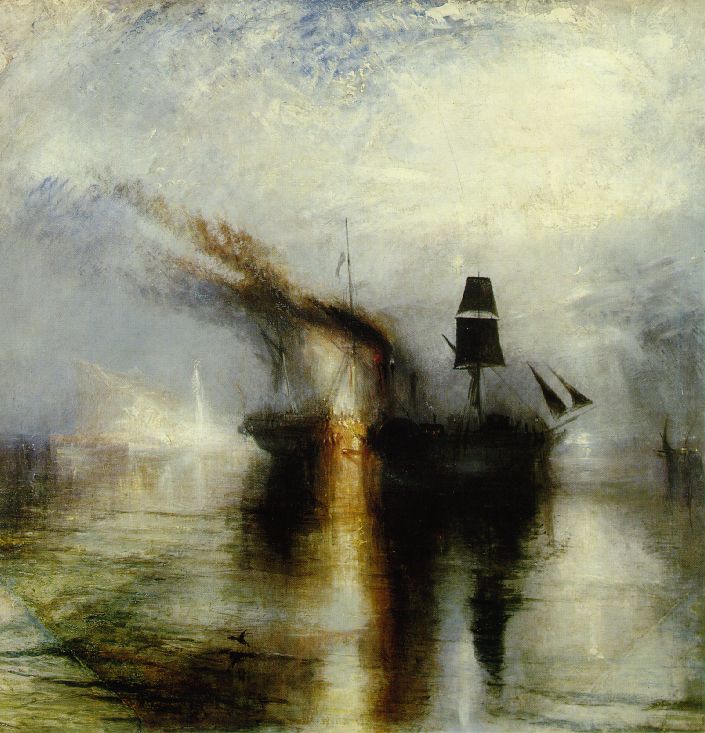
Turner. Peace-Burial at Sea. A memorial to Turner's contemporary, the portrait and genre painter Sir David Wilkie. Besides being a tribute to fame and friendship it was also a disingenuous demonstration of how to use black. s
”’The artist delights to go back to the first chaos of the world,” the critic William Hazlitt wrote of Joseph Mallord William Turner’s work in 1816, ”or to that state of things when the waters were separated from the dry land, and light from darkness, but as yet no living thing nor tree bearing fruit was seen on the face of the earth.” Hazlitt called him ”the ablest landscape painter now living”, but shared the concern of many of his contemporaries over Turner’s increasing tendency toward abstraction, though the concept as such did not exist. The surreal deformation and distortions of shape and form were greeted with suspicion as a heresy; as if painting were to undergo its proper reformation or Turner was to lead a new nation out of Egypt into places unknown. It was art whose abode was postmarked N.F.A.

Turner. Calais Pier. 1803. In this early painting Turner conveyed the excitement of a stormy day on the English Channel he knew so well; the mundane preparation of French fishermen and their wives are presented on an almost heroic scale. n
Calais Pier ( above) ”Turner’s picture is based on a real-life event. In 1802 he took his first trip abroad via Calais. On a sketch for this picture he noted that the seas had been so rough he was ‘nearly swamped’. The picture was exhibited at the Royal Academy in 1803. Like a number of Turner’s pictures it was not well received, and was thought unfinished in the foreground. ( Hoocher.com )
”All is without form and void. Someone said of his landscapes that they were ‘pictures of nothing, and very like’.” Though that process would only accelerate as the years went on, Turner the romantic and visionary would never totally divorce himself from form and subject. If he was ahead of his time, he was also very much part of it. However, Hazlitt’s remarks are not easily dismissible since his work on painting stood at the watershed between the Augustan and Romantic aesthetic. Thus, to ignore Hazlitt’s critique is to create a discontinuity in British aesthetics; the transition is lost from the Augustan neo-Platonic claims for painting urged by the strict classicist Reynolds, to at the other extreme, the John Ruskin conception that the greatest painting shows us a perceptual world so exalted as to be unrecognizable to most people; a world which is nevertheless still true, however different it may seem from the world we all see. The surreal qualities that challenge dimensionality are still valid, though beyond the standard deviation of objective classicism.
Above: As time went on, the artist became more and more fascinated with the destructive forces of nature, in particular with the interaction of fire and water. The burning of the Houses of Parliament in October, 1834, was an event tailor made to his preoccupation. Turner rushed to the scene, and dashing from one side of the Thames to the other, made quick water-color notes. He painted several versions of the disaster.
With Hazlitt, one encounters for the first time the claim that the function of the visual arts is to refine perception, and the secondary supportive claim is the agent of this refinement is a genius, whose perceptual world differs radically from that of other men. With Ruskin, one of Turner’s leading supporters, one is dealing with an approach to painting fully formed, confident of its mission, and uninterested in the question of ancestry.Hazlitt’s theory of the visual arts is essentially a product of the dialectic between the terms ”genius” and ”nature”. Traditional terms now made to perform in unfamiliar and inverted fashion. Genius being an absolute opposition to ”rules”; genius is that which cannot coexist with any kind of regularity or obedience to code which at the time seemed like a dangerous idea.
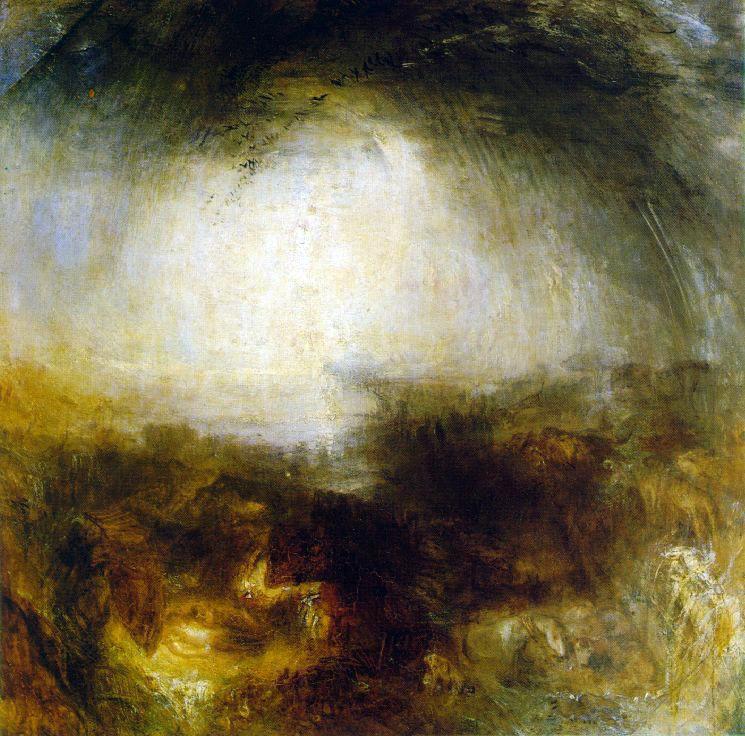
Turner. Shade and Darkness. One of Turner's late and most abstract oils , it was based on Goethe's color theories. The painting is dominated by what Goethe called ''minus colors'' which Goethe thought produced ''restless , susceptible, anxious impressions''; surely an apt description of the effect produced by a Turner painting.
”Looking at the swirling chaos in Turner’s vision of the Deluge’s aftermath, it is difficult to believe that it is founded on scientific ideas. Yet, Turner cites Goethe’s Theory, which he painstakingly studied once Eastlake’s translation was published in 1840. Here, he responds to Goethe’s “plus” and “minus” colors that address both the eyes and the emotions. The “plus” colors of yellow and red-yellow excite lively feelings, while blues impart gloomy and melancholy emotions, or “the impression of cold.” To Goethe, as Turner, yellow was above all associated with the sun and energy-giving qualities. Turner accompanies the first of the two paintings, Shade and Darkness – the Evening Before the Deluge, with verses from Fallacies of Hope, alluding to the line, “The moon put forth her sign of woe, unheeded.” The colors are, as we would expect, dark and low-key (Goethe’s “minus”) a
posed to the bright colors (including much yellow) of the aftermath of the Deluge. Nevertheless, Turner never believed in following any theory to the letter; rather, he interpreted it as he saw fit. This is very different from, for example, Monet’s more objective scientific view of the color theories from Goethe, Chevreul and other writers.”
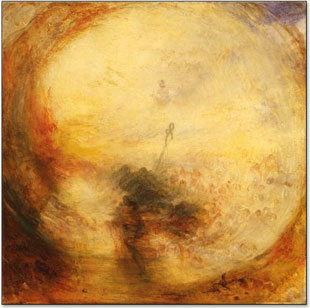
Turner. The Morning After the Deluge. 1843. '' He is intrigued by the anti-Newtonian doctrines expounded in Goethe’s Farbenlehre in 1810 that proposed that there are three core colors, not seven as Newton found. However, Turner feels that even Goethe had underappreciated the constructive role of darkness in the generation of color.''
As Turner battled the painting establishment and reinvented the parameters of what painting is; the current hitting North America, the ”We Want Miles Show” on jazz icon Miles Davis reveals that the creative process to expand and redefine an art is an ongoing combat not limited by traditional notions of culture; Davis literally reinvented jazz and was called the Picasso of Jazz because of his appetite for renewal and willingness to abandon formula.
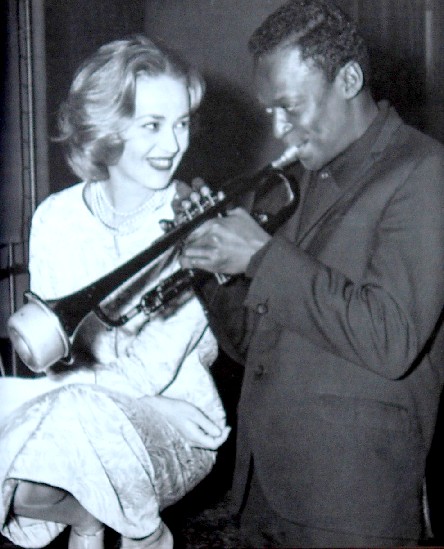
Miles Davis with Jeanne Moreau during the recordings of the soundtrack of the Louis Malle film "L'ascensour pour l'Echefaud
Like Turner, Davis was an enigmatic man, whose mystery was far more central an appeal than what was perceived as charisma. No one was as enigmatic as Miles Davis.Like Turner, he was driven by showmanship and a desire to be the best; Davis’s interviews were often outrageously arrogant, contentious, infuriating, yet just as often perceptive, generous, witty, wise. Above all, he was almost always controversial, from his musical risks to his dissolute lifestyle, and his attitude of entitlement. He infuriated critics by often playing with his back turned to audiences, rarely acknowledging them, sometimes leaving the stage when his musicians soloed.
“The real money was in getting to the mainstream,” Davis admitted. “I never thought that the music called ‘jazz’ was ever meant to reach just a small group of people, or become a museum thing.” Jazz critics and fans — insular and protective of the music’s early heritage — have always engaged in ongoing disagreements, often virulent, about what is and isn’t jazz. Davis, like Ellington, thought the word “jazz” was confining. ( Ron Rodriguez )



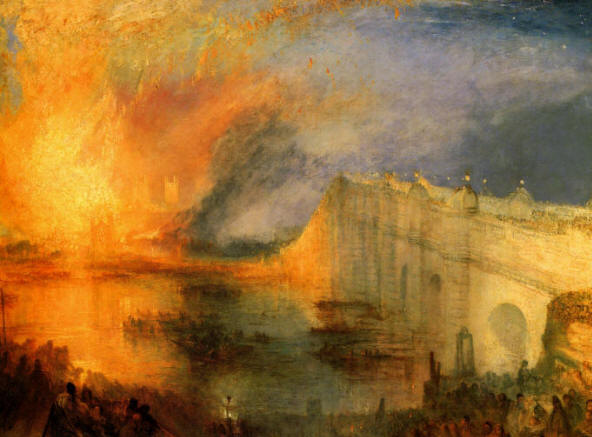




 COMMENTS
COMMENTS



